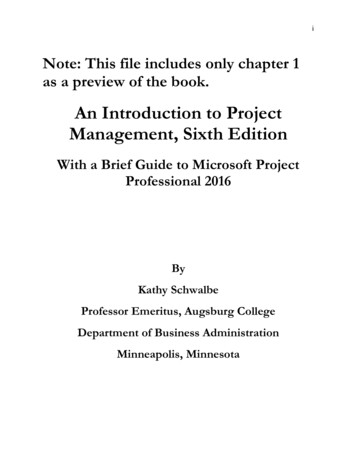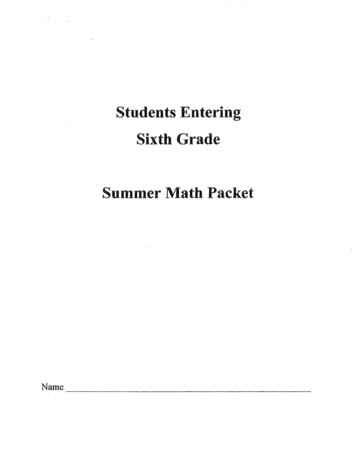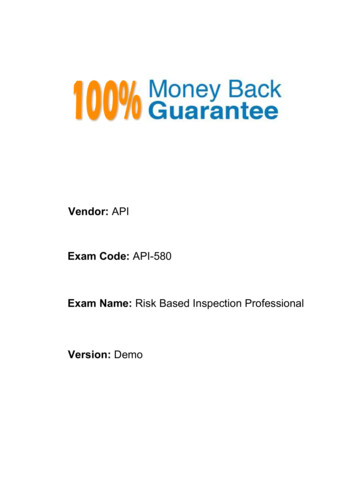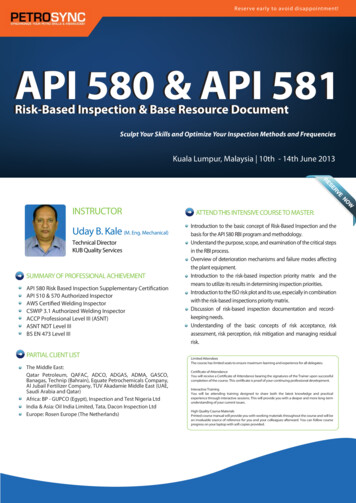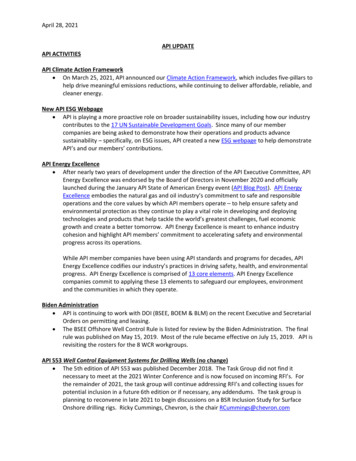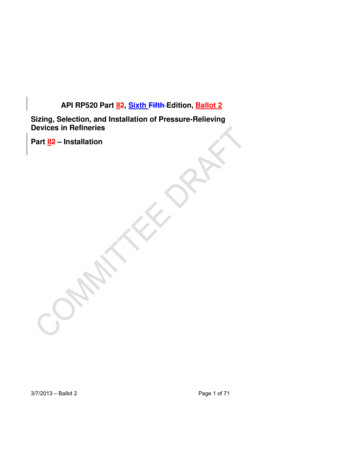
Transcription
API RP520 Part II2, Sixth Fifth Edition, Ballot 2Sizing, Selection, and Installation of Pressure-RelievingDevices in RefineriesPart II2 – Installation3/7/2013 – Ballot 2Page 1 of 71
CONTENTSSCOPE . 6REFERENCES . 62.1Normative References . 62.2Informative References . Error! Bookmark not defined.3. DEFINITION OF TERMS . 64. PRESSURE RELIEF DEVICE LOCATION . 64.1Proximity To Protected Equipment . 74.2Pressure Fluctuations . 74.3Vibration . 74.4Operating Environment . 84.5Free Draining . 84.6Maintainability . 85. INLET PIPING REQUIREMENTS . 85.1General . 85.2Minimum Diameter . 85.3Layout . 85.4Isolation Valves In Inlet Piping . 85.5Process Laterals Connected To Inlet Piping Of Pressure Relief Valves . 85.6PRV Inlet Line Length and Pressure Loss . 95.7Inlet Stresses That Originate From Static Loads In The Discharge Piping . 95.7.1Thermal Stresses . 95.7.2Mechanical Stresses . 95.8Inlet Stresses That Originate From Discharge Reaction Forces . 95.8.1Determining Reaction Forces In An Open Discharge System . 95.8.2Determining Reaction Forces in a Closed Discharge System . 116. DISCHARGE PIPING FROM PRESSURE RELIEF DEVICES . 116.1General Requirements . 116.2Safe Disposal Of Relieving Fluids . 116.3Back Pressure Limitations And Sizing Of Pipe . 116.3.1General . 116.3.2Thermal Relief Valves. 126.4Considerations For Pilot-Operated Pressure Relief Valves . 126.5Stresses In Discharge Piping During Release . 126.6Isolation Valves In The Discharge Piping . 126.7Rupture Disks Installed At Outlet Of Pressure Relief Valve . 127. PRV STABILITY. 137.1General . 137.1.1PRV Cycling . 137.1.2PRV Flutter . 137.1.3PRV Chatter . 137.2Potential Causes of PRV Instability . 147.2.1General . 147.2.2Excessive PRV Inlet Pressure Loss . 147.2.3Excessive Built-up Backpressure . 147.2.4Acoustic Interaction . 141.2.3/7/2013 – Ballot 2Page 2 of 71
7.2.5Retrograde Condensation. 157.2.6Improper Valve Selection. 157.3PRV Inlet Pressure-Drop Limitations . 157.3.1General . 157.3.2Pressure Relief Valve Capacity . 167.3.3Adjustments to Set Pressures Based on Upstream System . 167.3.4PRV Inlet Loss Criteria . 167.3.5Background on PRV Inlet Pressure Loss Criteria . 177.3.6Engineering Analysis . 177.3.7Calculating Non-recoverable PRV Inlet Losses . 187.3.8Inlet Loss Criteria for Thermal Relief Valves. 197.3.9Inlet Loss Criteria for Remote Sensing for Pilot-Operated Pressure-ReliefValves 207.4PRV Selection. 208. ISOLATION (STOP) VALVES IN PRESSURE RELIEF PIPING . 228.1General . 228.2Application . 228.3Isolation Valve Requirements . 238.3.1General . 238.3.2Inlet and Outlet Isolation Valves . 238.3.3Installation of Spare Relief Capacity . 248.3.4Three-Way Changeover Valves For Dual Pressure Relief DeviceInstallations . 258.3.5Use of Ball Valves as Three-Way Changeover Valve . 258.4Examples Of Isolation Valve Installations . 258.5Administrative Controls Related To Isolation Valves . 269. RUPTURE DISK INSTALLATIONS . 269.1Rupture Disk Devices In Combination With Pressure Relief Valves . 269.2Rupture Disks In Series . 2610.BONNET OR PILOT VENT PIPING . 2710.1 General . 2710.2 Conventional Valves . 2710.3 Balanced Bellows Valves . 2710.3.1 General . 2710.3.2 Bonnet Vent for Bellows Valve Handling Non-Hazardous Vapors . 2810.3.3 Bonnet Vent for Bellows Valve Handling Hazardous Vapors . 2810.3.4 Bonnet Vent for Bellows Valve Handling Non-Hazardous Liquids . 2810.3.5 Bonnet Vent for Bellows Valve Handling Hazardous Liquids . 2810.4 Balanced Piston Valves . 2810.5 Pilot-Operated Valves . 2811.DRAIN PIPING . 2911.1 Installation Conditions That Require Drain Piping. 2911.2 Safe Practice For Installation Of Drain Piping . 2912.PRE-INSTALLATION HANDLING AND INSPECTION . 2912.1 General . 2912.2 Storage And Handling Of Pressure Relief Devices . 293/7/2013 – Ballot 2Page 3 of 71
12.3 Inspection And Cleaning Of Systems Before Installation . 3013.PRESSURE-RELIEF DEVICE INSTALLATION AND MAINTENANCE . 3013.1 Mounting Position . 3013.1 Care In Installation . 3013.2 Pressure Relief Valves . 3013.3 Rupture Disk Devices . 3113.4 Pin-Actuated Devices . 3113.5 Proper Gasketing And Bolting For Service Requirements . 3113.6 Inspection And Maintenance. 3113.7 Test Or Lifting Levers . 3113.8 Heat Tracing And Insulation. 32Figure 1 – Typical Pressure Relief Valve Installation: Atmospheric (Open) Discharge . 34Figure 2 – Typical Pressure Relief Valve Installation: Closed System Discharge . 35Figure 3 - Typical Rupture Disk Device Installation: Atmospheric (Open) Discharge . 36Figure 4 – Typical Pressure Relief Valve Mounted on Process Line . 38Figure 5 – Typical Pressure Relief Valve Mounted on Long Inlet Pipe. 39Figure 6 – Typical Pilot-Operated Pressure Relief Valve Installation . 40Figure 7 – Typical Pressure Relief Valve Installation with Vent Pipe . 41Figure 8 - Typical Rupture Disk Device In Combination With Relief Valve: Inlet SideInstallation. 42Figure 9 – Avoiding Process Laterals Connected to Pressure Relief Valve Inlet Piping . 43Figure 10 – Typical Pressure Relief Device Installation with an Isolation Valve . 44Figure 11 – Typical Pressure Relief Device Installation for 100 Percent Spare RelievingCapacity . 45Figure 12 – Alternate Pressure Relief Device Arrangement for 100 Percent SpareRelieving Capacity . 46Figure 13 – Alternate Pressure Relief Device Installation Arrangement for 100 PercentSpare Relieving Capacity . 47Figure 14 – Three-Way Changeover Valve – Shuttle Type . 48Figure 15 – Three-Way Changeover Valve – Rotor Type . 49Figure 16 – Three-Way Changeover Valve – Ball Types . 50Figure 17 – Typical Flare Header Block Valves . 51Figure 18 – Typical Isolation Block Valves for Spare Compressor . 52Figure 23 – Typical Installation Avoiding Unstable Flow Patterns at Pressure relief ValveInlet . 57APPENDIX A – RUPTURE DISK INSTALLATION GUIDELINES . 58Figure A.1 – Typical Configuration of Companion Flanges, Gaskets and Rupture DiskAssembly .
API STDRP 520 Sizing, Selection, and Installation of Pressure–Relieving Devices in Refineries, Part I1 – Sizing and Selection 3. DEFINITION OF TERMS The terminology for pressure relief devices that is used in this recommended practiceStandard is in general agreement with the definitions given in API Recommended PracticeSTDRP 520 Part I1. 4. PRESSURE RELIEF DEVICE LOCATION AND File Size: 1MBPage Count: 74
![API Ballot: [Ballot ID] – API 510 & API 570, Deferrals, Rev05](/img/5/api510andapi570deferralsrev5.jpg)


